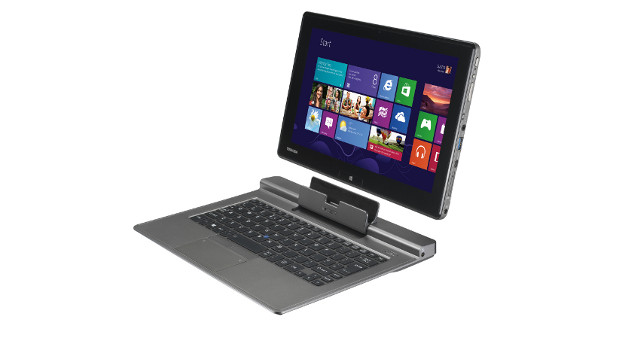One of the trends that has emerged in recent years with personal computers is a whole host of new formats, from the ultrabook laptop, to tablets that are full PCs and hybrids — that is a laptop that turns into a tablet.
The Toshiba Portege Z10t is an ultrabook class machine that sports a 295mm (11.6”) screen, measuring 299 x 220.5 x 16.9mm and 19.9mm thick, weighing 1.45kg that comes with a keyboard chassis that turns it into a fully-fledged laptop.
As a tablet, it is light enough to manipulate with one hand while using the touch interface, though it does start to feel heavy after a while.
As a tablet, it has a good range of ports, miniHDMI, USB, audio and full-sized SDcard slot. When docked with its chassis, it gains Ethernet, VGA, full-sized HDMI and another USB. There are forward (1MP) and rear (3MP) facing cameras too.
Clamshell chassis is solid, but its metal base just reinforces the plastic feel of the tablet portion. The docking mechanism is good and easy to use, but despite the excellent viewing angle of the screen, the maximum opening angle for the screen is poor, leaving you looking at it at a rather oblique angle when used on the lap, or an airplane tray table.
The vital statistics for the test model, the Z10t-A-106, are a 128GB SSD drive, a Core i5 – 3339Y processor with 4GB of RAM and Intel 4000 HD graphics chip. This places it firmly in Surface Pro territory, a little behind Surface Pro II territory, which is good as we had both devices on hand for comparison.
There is not much in it in terms of weight, and both Surface devices lose out in terms of screen size, but definitely not in terms of performance. While the Z10t’s display is crisp, and large, it loses out slightly in colour reproduction where there is a certain lack of vibrancy in some of the brighter areas of the palette. Now this was in relation to the Surface Pro II and so is comparative, as opposed to any great dearth of ability. But as our test unit, the Z10t-A-106, sports an “Ultrabook” sticker, it is a careful blend of performance and power management that serves a fairly wide audience so as a business device, this is no criticism at all.
The Y class i5 processor is a bit down on processing power, though low in power consumption, but this is not really noticeable in a business setting. Thanks to the SSD, applications load quickly and the interface is fluid. The device is responsive and there is a digital pen option, though perhaps unsurprisingly, the digital pens form other devices did not seem to work with the Z10t.
The unit comes with Windows 8 installed, and despite the fact that the Windows install was activated, there was no 8.1 update option.
There is an impressive preload of Toshiba and other applications, such as McAfee Internet Security and Microsoft Office 2013 1 month trial for new users. The Toshiba applications include Desktop Assist, Display and Eco utilities, Media Player, PC Health Monitor and DTS Sound Studio.
There’s also a pre-install of Spotify.
Claimed battery life is 5 hours, based on the MobileMark benchmark, so for relatively light usage the 6 hour mark should be possible. In testing we had fairly light usage, but never had to power down due to battery run out.
All of which brings us to the price. Dabs.ie has the Z10t-A-103 for €1,438. The tested model was the higher spec Z10t-A-106, for which, at time of writing, we could not find a retail price. However, the Surface Pro II retails in similar configuration (4GB RAM and 128 GB SSD) for €999, though admittedly without a keyboard. The Pro II with dock and Type II keyboard would come to €1,338.98. So the Z10t-A-106 is pricey for the performance it delivers. However, its larger screen and careful balance of power consumption and performance, along with the extra usability in its extended chassis means that it remains competitive.
TechCentral Reporters








Subscribers 0
Fans 0
Followers 0
Followers